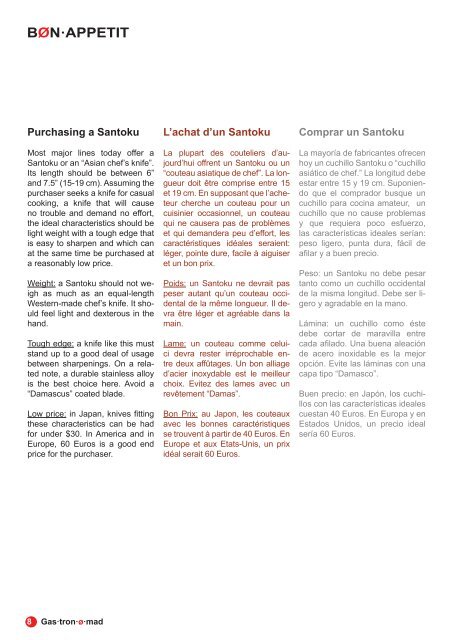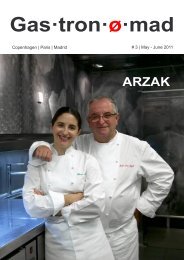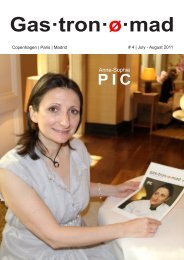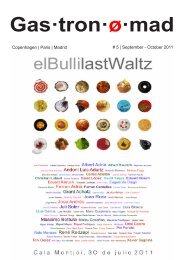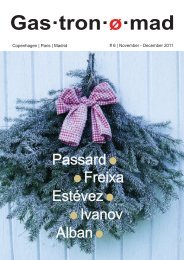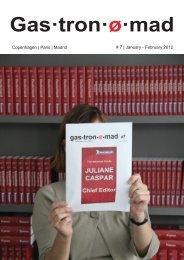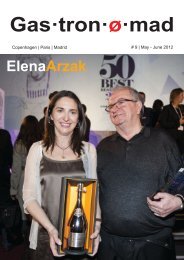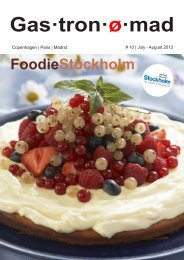Gastronomad #8 March - April 2012
You also want an ePaper? Increase the reach of your titles
YUMPU automatically turns print PDFs into web optimized ePapers that Google loves.
BØN·APPETIT<br />
Purchasing a Santoku<br />
Most major lines today offer a<br />
Santoku or an “Asian chef’s knife”.<br />
Its length should be between 6”<br />
and 7.5” (15-19 cm). Assuming the<br />
purchaser seeks a knife for casual<br />
cooking, a knife that will cause<br />
no trouble and demand no effort,<br />
the ideal characteristics should be<br />
light weight with a tough edge that<br />
is easy to sharpen and which can<br />
at the same time be purchased at<br />
a reasonably low price.<br />
Weight: a Santoku should not weigh<br />
as much as an equal-length<br />
Western-made chef’s knife. It should<br />
feel light and dexterous in the<br />
hand.<br />
Tough edge: a knife like this must<br />
stand up to a good deal of usage<br />
between sharpenings. On a related<br />
note, a durable stainless alloy<br />
is the best choice here. Avoid a<br />
“Damascus” coated blade.<br />
Low price: in Japan, knives fitting<br />
these characteristics can be had<br />
for under $30. In America and in<br />
Europe, 60 Euros is a good end<br />
price for the purchaser.<br />
L’achat d’un Santoku<br />
La plupart des couteliers d’aujourd’hui<br />
offrent un Santoku ou un<br />
“couteau asiatique de chef”. La longueur<br />
doit être comprise entre 15<br />
et 19 cm. En supposant que l’acheteur<br />
cherche un couteau pour un<br />
cuisinier occasionnel, un couteau<br />
qui ne causera pas de problèmes<br />
et qui demandera peu d’effort, les<br />
caractéristiques idéales seraient:<br />
léger, pointe dure, facile à aiguiser<br />
et un bon prix.<br />
Poids: un Santoku ne devrait pas<br />
peser autant qu’un couteau occidental<br />
de la même longueur. Il devra<br />
être léger et agréable dans la<br />
main.<br />
Lame: un couteau comme celuici<br />
devra rester irréprochable entre<br />
deux affûtages. Un bon alliage<br />
d’acier inoxydable est le meilleur<br />
choix. Evitez des lames avec un<br />
revêtement “Damas”.<br />
Bon Prix: au Japon, les couteaux<br />
avec les bonnes caractéristiques<br />
se trouvent à partir de 40 Euros. En<br />
Europe et aux Etats-Unis, un prix<br />
idéal serait 60 Euros.<br />
Comprar un Santoku<br />
La mayoría de fabricantes ofrecen<br />
hoy un cuchillo Santoku o “cuchillo<br />
asiático de chef.” La longitud debe<br />
estar entre 15 y 19 cm. Suponiendo<br />
que el comprador busque un<br />
cuchillo para cocina amateur, un<br />
cuchillo que no cause problemas<br />
y que requiera poco esfuerzo,<br />
las características ideales serían:<br />
peso ligero, punta dura, fácil de<br />
afilar y a buen precio.<br />
Peso: un Santoku no debe pesar<br />
tanto como un cuchillo occidental<br />
de la misma longitud. Debe ser ligero<br />
y agradable en la mano.<br />
Lámina: un cuchillo como éste<br />
debe cortar de maravilla entre<br />
cada afilado. Una buena aleación<br />
de acero inoxidable es la mejor<br />
opción. Evite las láminas con una<br />
capa tipo “Damasco”.<br />
Buen precio: en Japón, los cuchillos<br />
con las características ideales<br />
cuestan 40 Euros. En Europa y en<br />
Estados Unidos, un precio ideal<br />
sería 60 Euros.<br />
A taste of history | Le saveur de l´histoire | El sabor de la historia<br />
8 Gastronømad Gastronømad 9


